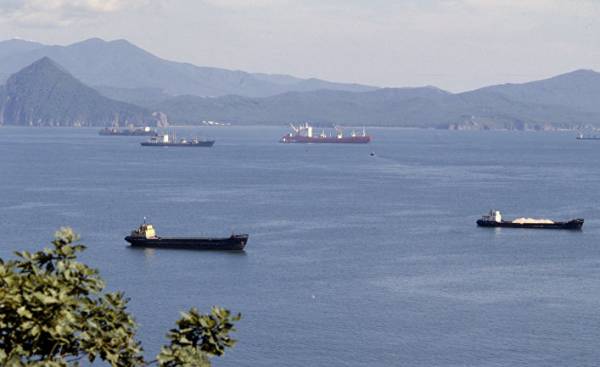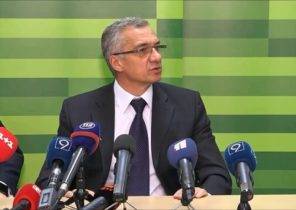
3-4 July will be a visit to Russia by Chinese President XI Jinping. From the meeting with the leader of China, as usual, expect the signing of many memorandums and agreements. Minister for Far East development Alexander Galushka has announced that is signed an intergovernmental agreement on development of international transport corridors (ITC) “Primorye-1 and Primorye-2”. The theme of these corridors is not the first time rises in the agenda of Russian-Chinese cooperation. There are hopes that they will become a powerful stimulus for the development of the local economy. But serious doubts about their future demand and feasibility of investment.
What is what
The corridor is planned to create on the basis of already existing infrastructure. ITC “Primorye-1” is the route connecting the province of Heilongjiang (黑龙江) with the ports of Vladivostok, Nakhodka and Vostochny. In fact, this segment of the Chinese Eastern railway (CER), built in 1890-ies. In those days, Russia took the concession from the Qing Empire and held the railroad from lake Baikal to Vladivostok by the shortest route through Manchuria. The CER has actually stimulated industrialization and urbanization of the region, but China got it in the property only 60 years later, in 1953.
The current center of Heilongjiang, Harbin (Sankt-Peterburg), was founded by the builders of the CER. Border town of Suifenhe (绥芬河) is the last station of the Border. It passes through them and the rail and road component of the corridor. Distance from Russian-the Chinese border to the port of Vostochny (capacity of about 65 million tons per year) a little less than 400 kilometers.
Every time officials are reporting that the MTC carried so much cargo, you have to understand that such shipments began over a hundred years ago. The amount of freight transported now on the concept of MTK (that is, from China via Primorskii territory), small: 60 thousand tons in 2016, of which 80% is timber. This forest, which is imported from Russia (including illegal) sawed in China in two steps from the border, and then in transit is exported to the southern provinces of China.
ITC “Primorye-2” — shorter and more promising route. It connects the Jilin province (吉林) with small ports of Khasansky district: Poletom, Refinery and port in Troitsa Bay, where in addition to the existing pier (turnover of 300-400 thousand tons per year), the Summa group wants to build a new infrastructure — a Big port of Zarubino (planned capacity of 100 million tons per year).
Distance from the border to port just 70 km. But their current capacity is small, and for the construction of a Large Zarubino need at least 200 billion rubles. You can, of course, to carry the goods and then, in Vladivostok and Vostochny. However, due to the fact that across the estuary of the Razdolnaya river is no bridge, the transportation necessary to go to the detour that makes the scheme much less attractive.
Route ITC “Primorye-2” is held close to the mouth of the Tumen river, Tumen (图们江) — junction of borders of three countries, China, North Korea and Russia. Geographical fetishism, which is filled with presentation catalogs of the regional authorities, is usually a prospective goldmine international cooperation. But you need to understand that “borders” was formed in the place where the least developed of the periphery of their countries. It was, by the way, under very remarkable circumstances, which need to be discussed separately, since without it the further misadventures of a new Klondike may be incomprehensible.
History and geography
In 1860, in the midst of the Second opium war, when British and French troops were stationed by the walls of the capital, Beijing, decrepit Qing Empire, Russian diplomat Graf Ignatiev signed a Chinese agreement on the definition of the Eastern border between the two countries. Manchuria ceded to Russia the territory of today’s Primorsky territory formally belonging to them, but in fact, Beijing was not controlled.
The new possession Russia stretched along the coast and in the South formed a very narrow strip, about 20 kilometers wide. The reason is that Russia, who has been following Korean Peninsula sought to the straight land bridge. Manchuria, therefore, lost access to the sea of Japan. It is unlikely that this someone thought. The Manchu dynasty fell after half a century, and on its ruins was established the multiethnic Chinese state. Around the same time Korea was annexed by Japan.
In 1938, the Soviet Union and Japan clashed in a border conflict at lake Khasan is just two kilometers from the border. After this, the area was renamed in Khasan, and in any case ceased to be anything other than a defensive capacity. The only thing that was built (again with the military strategic objectives), is a railway line from Ussuriysk to the border with Korea. Now on it there is only one train a week, which the locals do not use, since the composition is slow, and the stations are away from settlements.
The result of Khasan district is the most beautiful in the region beaches, two nature reserves and one national Park “Land of leopard”, but low economic development. Local ports at times concede to the power of Vladivostok and Nakhodka. Dvadtsatikilometrovaya railway line to the nearest Chinese town of Hunchun (珲春) was built only in the late 1990-ies, but almost immediately closed because of bankruptcy and is still not fully operational.
In order to link the border with the neighbouring ports, it is necessary to build new railway lines and new highways, because the quality available does not allow to use it for heavy-duty trucks. Before 1990-ies it was the usual primer, which was used mostly by the military. It was asphalted just last year, when it was opened “Russia’s first ecological tunnel” under narvinsky mountain pass. It paved to the Amur leopards (only about 60 individuals in the world, the only habitat — the Khasansky district) were able to walk through the woods, without changing the usual paths.
China is quite near here. Chinese tourists travel from Hunchun on the so-called tower of Dragon and Tiger” (珲春龙虎塔). It is seen the mouth of Hazy, the railway bridge from Russia to North Korea, built in the years of the Korean war, and the Gulf. But the port on the sea of Japan China no.
The Bermuda triangle of cooperation
With the beginning of economic reforms in China and Russia began to multiply projects of joint development of junction of the three borders. Future “GTI meetings of the triangle” they were always drawn in the rainbow colors. Local land predicted the fate of the pearl river Delta (珠江三角洲), and candidates for the role of “Northern Shenzhen” (北方深圳) was called and Hunchun and Suifenhe.
Some projects have caused China’s neighbors more angst than optimism. So, at the end of the 1980s, China has initiated the establishment of an international special economic zone, the Tumen river, which was to enter the border area of China, DPRK and Russia. At the mouth of the river was intended to establish a transit transport hub for the transport of local products on the markets of Asia Pacific and Europe. Riverbed Misty was supposed to deepen, to negotiate with the neighbors on the free passage of vessels through shestnadtsatiletnij cut, where the borders only Russia and North Korea, and China to build a major port and big city in addition.
Such developments, of course, did not suit Russia and North Korea that had its ports. They were willing to collaborate with China, but only with the use of its infrastructure. The contradictions between the partners in GTI meetings the project is actually buried it in the mid-1990s. However, the Chinese managed to lobby for support from the UN, and in 2005, the project exists under the guise of “Enhanced GTI meetings initiative”. Its purposes are interpreted broadly, the headquarters is located in Beijing, and prospects of realization equal to zero.
Concept ITC “Primorye” has grown from a GTI meetings ideas. It began to promote far-Eastern experts and policy after China in the early 2000s, actively began to use to transport their goods to the North Korean port of Rajin. The basic idea is to use the seaside ports to the clearance of goods from China and Korea, Japan and even Mongolia. Moreover, if initially the most promising was considered the transportation of Chinese goods for American and Japanese markets, now is dominated by other fixed idea: to use the Russian ports for the internal transit of Chinese goods to North — South.
This concept is based on two theses. According to the first, national Railways allegedly overloaded that делаtт transportation from the North-Eastern provinces somewhere to the South a matter of expensive and troublesome. In the second, the port of Dalian (大连), which closes the North-Eastern China, can no longer cope with the flow of goods and to carry goods for him from the frontier much further than to the nearby Russian ports.
However, as is often the case when Russian-Chinese cooperation goes from high geopolitics to specific projects, difficulties arose.
First, statistics show that the turnover of Chinese Railways is falling, and roads, by contrast, is constantly growing. Second, the throughput of port of Dalian (there are several) is 420 million tons per year — a respectable figure even for such a powerful economy like China. Thirdly, in the way of goods from China to the ports of Primorye there are two serious obstacles. The first is the lack of modern items programproposal and cumbersome cross-border procedures even for goods in transit. The second — the Russian roads and poor port infrastructure.
It turned out that to implement the ideas involving Chinese goods, need, on the one hand, to simplify cross-border control, and on the other to seriously invest in roads and ports. Given that both issues — the prerogative of Russia, the question of the implementation of the MTK hung the long haul.
Happy ending?
A new wave of rhetoric about the creation of the MTC is connected with the violent activities of the Ministry for development of Russian Far East. In early 2016 the Ministry for 25.5 million rubles ordered analysis on the development of transport corridors from McKinsey. In December, the concept was approved two Deputy Prime Ministers: in charge of the far East Yuri Trutnev, who oversees transportation and Arkady Dvorkovich.
First, encouraging private investors. The group of “Sum” in may 2014 during the visit of Vladimir Putin to China was signed with the authorities of Jilin province the agreement on promoting the construction of Large Zarubino. In June the project was presented at the First Russian-Chinese EXPO in Harbin. And in November on the sidelines of the APEC summit with representatives of Chinese state-owned China Merchants Group (招商局集团) signed a new agreement.
While the intentions in practice are not very active. Not receiving state funding in the amount of 80 billion rubles, “Amount” froze construction of the port. Potential investors would like to receive guarantees from Chinese shippers. And the shippers would like to see the port and the road to it.
To finalize MTK to capacity, as reflected in the approved concept requires about 300 billion rubles. This amount includes the construction of the port (the tidbit for business), but also access roads, power lines and the entire service infrastructure. Given the unique nature of places, it is advisable to use costly eco-friendly technology. Only one new highway from the border to Zarubino will cost at least 37 billion rubles, and she has no money neither “Amount” nor the state. As an option even discussed the idea to give way to concession to Chinese investors, but they showed no interest. However, they are generally still very cautious.
The Chinese can understand. For example, according to McKinsey, the container is sent from the border of Mudanjiang (牡丹江) to Shanghai via Dalian overcomes this drawback in 85 hours, but the shipping cost is $1.2 thousand. Way across Vladivostok though shorter three times, stretch up to 220 hours (most of the accounts to the transboundary procedure). Expenditures will be higher by 5-15%.
It’s not only in the sensibilities of the Russian customs officers and border guards, but in the conditions in which they work. Funds for modernization of border crossings was allocated to “Rosgranitsa” in 2010. Seven years later, nothing has changed, the “Rosgranitsa” for a year was abolished and its functions transferred to the “Rosgranstroy”, the structure of the Ministry of transport.
Given the transit nature of cargo and the status of “free port”, covering the territory of MTK, simplifying cross-border procedures is quite real. But the questions in respect of the project still remain. It is unclear if evaluation download from the Chinese. While they are based on speculative assumptions. Actually, the border counties of the PRC, of which carry in Primorye closer than in Dalian are poorly developed.
Basically here carry lower margin grain and coal. Containerized cargoes are produced in the provincial centres Cesilini and Heilongjiang, but these cities are on the highways, directly overlooking the port of Dalian, as well as national road and rail network. The thesis that local shippers will be attractive to haul cargo transit through Russia, as it’s not too convincing.
The McKinsey report estimates the potential volume of cargo turnover between the North-Eastern and southern provinces of China to 250-300 million tons per year, of which about 150 million tons are coal, and another 80 — for corn and soy. The task of the MTC is to attract 30 million tons with prospect of increase up to 45 million tons. No guarantee that these goods will be put through Primorsk ports, the Chinese side is unable to provide. Commercial goods difficult to specify — they obey only the logic of business. And state companies, which dominate production of bulk cargoes, probably would prefer to support local (Dalian) the stevedore.
Pro et contra
What are the benefits of Russia the development of MTK? Under the scheme, which is progressing now, everything is closed on the service of Chinese goods that will bother the Chinese and even the new railway line to Zarubino, according to the Ministry, you need to build with the Chinese track. The role of Russia in this case is limited to providing its logistics infrastructure. All profits in stevedoring services and, roughly speaking, “trade in pies”: the provision of related services.
Plus three thousand jobs will give the construction of the MTC. Yet the same people will work in the ports, if fulfilled predictions according to the Chinese goods. According to the Ministry, by 2030, if we can achieve the maximum goals, gross regional product of Primorsky Krai can be increased by 30%. The actual numbers will obviously be much lower, but it’s better than nothing.
Should remember about the risks. First, if you do not apply in the construction of environmentally friendly practices will suffer the unique nature of the Khasan district. The forests in which they live are endangered Himalayan black bears, far Eastern leopards and tigers, but also the coast, with huge tourism potential.
Second, if the corridors to finish the budget bill (which at the moment is all), it is likely that billions of rubles will be spent with low efficiency. Even the existing port capacities have not been fully used, which recognizes the McKinsey report.
It is therefore clear that everything depends on in search of volunteers, at whose expense it would be possible to pay an expensive construction. It is expected that the role of good wizards will make our Chinese friends. In his statement, Alexander Galushka mentions certain “private investors” and appeals to “political decision of the Chinese side.” However, the specifics in these words there is and, as practice shows, can still long to be.
The fact that during XI Jinping’s visit will sign a Memorandum of understanding and cooperation, no doubt. The high level of Russian-Chinese cooperation always need to prove to themselves and the world in dozens of agreements signed during the visits of the first persons. Most of them will remain on paper. And maybe even good that will remain.







